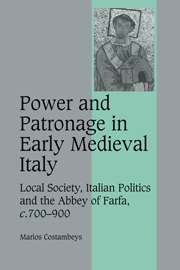 Power and Patronage in Early Medieval Italy
Power and Patronage in Early Medieval Italy Book contents
- Frontmatter
- Contents
- List of illustrations
- Acknowledgements
- Note on charter editions
- List of abbreviations
- Maps
- 1 INTRODUCTION
- 2 PATRONAGE AND LOMBARD RULERS
- 3 AUTHORITY, RULERSHIP AND THE ABBEY
- 4 THE MONKS AND ABBOTS OF FARFA: IDENTITIES AND AFFILIATIONS
- 5 SABINE LANDS AND LANDOWNERS
- 6 ELITE FAMILIES IN THE SABINA
- 7 FARFA AND ITALIAN POLITICS IN THE LOMBARD ERA
- 8 FARFA, ITALIAN POLITICS AND THE CAROLINGIANS
- Bibliography
- Index
- Cambridge Studies in Medieval Life and ThoughtFourth Series
6 - ELITE FAMILIES IN THE SABINA
Published online by Cambridge University Press: 17 July 2009
- Frontmatter
- Contents
- List of illustrations
- Acknowledgements
- Note on charter editions
- List of abbreviations
- Maps
- 1 INTRODUCTION
- 2 PATRONAGE AND LOMBARD RULERS
- 3 AUTHORITY, RULERSHIP AND THE ABBEY
- 4 THE MONKS AND ABBOTS OF FARFA: IDENTITIES AND AFFILIATIONS
- 5 SABINE LANDS AND LANDOWNERS
- 6 ELITE FAMILIES IN THE SABINA
- 7 FARFA AND ITALIAN POLITICS IN THE LOMBARD ERA
- 8 FARFA, ITALIAN POLITICS AND THE CAROLINGIANS
- Bibliography
- Index
- Cambridge Studies in Medieval Life and ThoughtFourth Series
Summary
INTRODUCTION
Among the landed aristocrats associated with Farfa in the eighth-century charters, several families stand out. Their prominence does not, however, always or necessarily indicate that their association with the abbey was one of unqualified support, material or otherwise. They appear sometimes simply because their influence in the Sabina meant that they had a hand in all important aspects of the region's life. Farfa could not avoid dealing with them; nor, on the other hand, could they ignore Farfa, an indication if any were needed that the abbey quickly became the most important religious institution in the region.
Farfa, however, was not the only institution in the region. We must always be aware that its dominance of our record might encourage us to inflate its dominance in reality. At least before the intervention of the Carolingians, the Sabine elite could choose where to lavish their patronage, so the fact that they so often chose to direct it to Farfa itself needs investigation.
Although Farfa stood, and still stands, in a distinctly rural part of central Italy, an account of its relations with its patrons in this period must begin in the nearest city, Rieti. We have already seen that Rieti was the seat of the diocese in which most of Farfa's lands lay, and its bishop was the one with whom the abbey had by far the most interaction. From the bishop's perspective, Farfa's position was anomalous, to say the least.
- Type
- Chapter
- Information
- Power and Patronage in Early Medieval ItalyLocal Society, Italian Politics and the Abbey of Farfa, c.700–900, pp. 225 - 249Publisher: Cambridge University PressPrint publication year: 2007
